This April, we are highlighting a species with a real tongue-twister of a Latvian name – priežu sveķotājkoksngrauzis (Nothorhina muricata).
The beetle has an elongated and flattened body shape. The elytra, head, and pronotum are dark brown, while the legs and antennae are brown. The pronotum is rough-textured with a lighter patch in the center. The body surface is covered with fine hairs. It can be distinguished from other similar species living in the same habitat by its relatively small size.
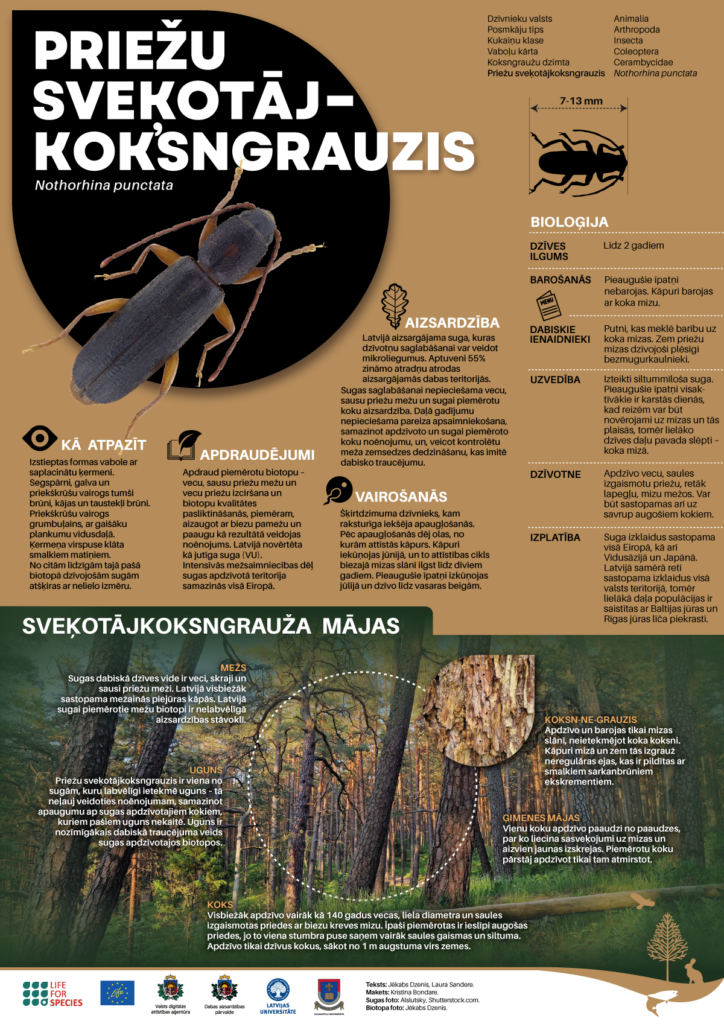
Interesting fact: The beetle is one of the species positively affected by fire – fire prevents excessive shading by reducing undergrowth around the beetle's host trees, which are themselves resistant to fire. Fire is the most important natural disturbance factor in the beetle’s habitats.
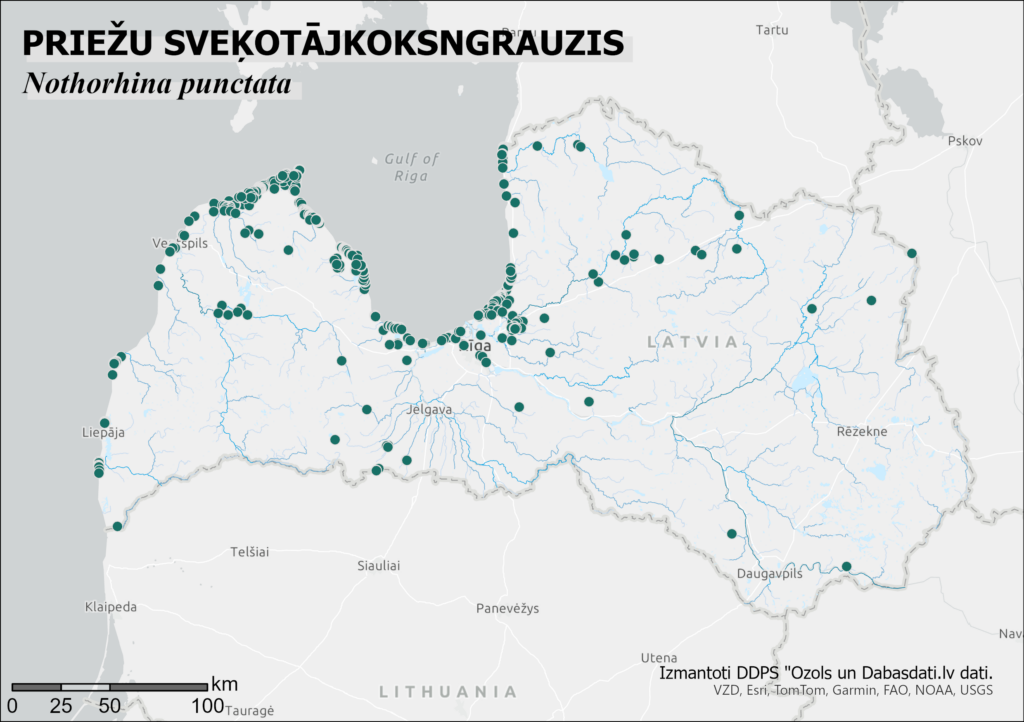
Map by Jānis Ukass
In Latvia, the species is threatened by the loss of suitable habitat – specifically, the logging of old, dry pine forests and the decline in habitat quality caused by overgrowth of dense underbrush and young trees, which leads to increased shading. The species has been assessed as Vulnerable (VU) in the project. Unfortunately, due to intensive forestry practices, its range is declining across Europe.
Do you know which is the smallest owl species living in Latvia and Europe? It’s this month’s protected species – the pygmy owl (Glaucidium passerinum).
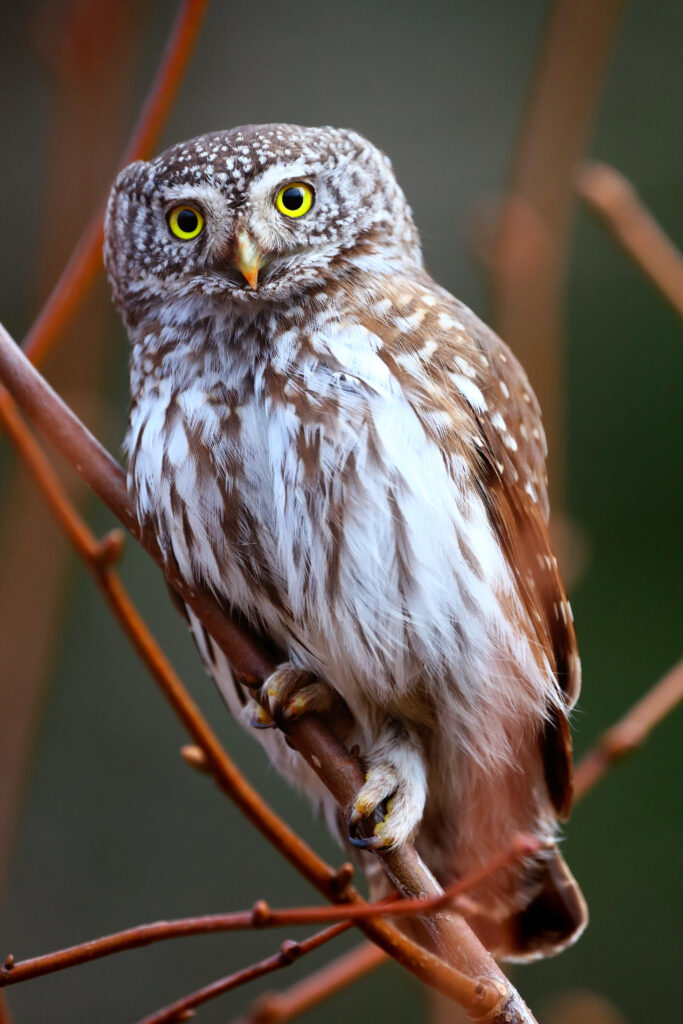
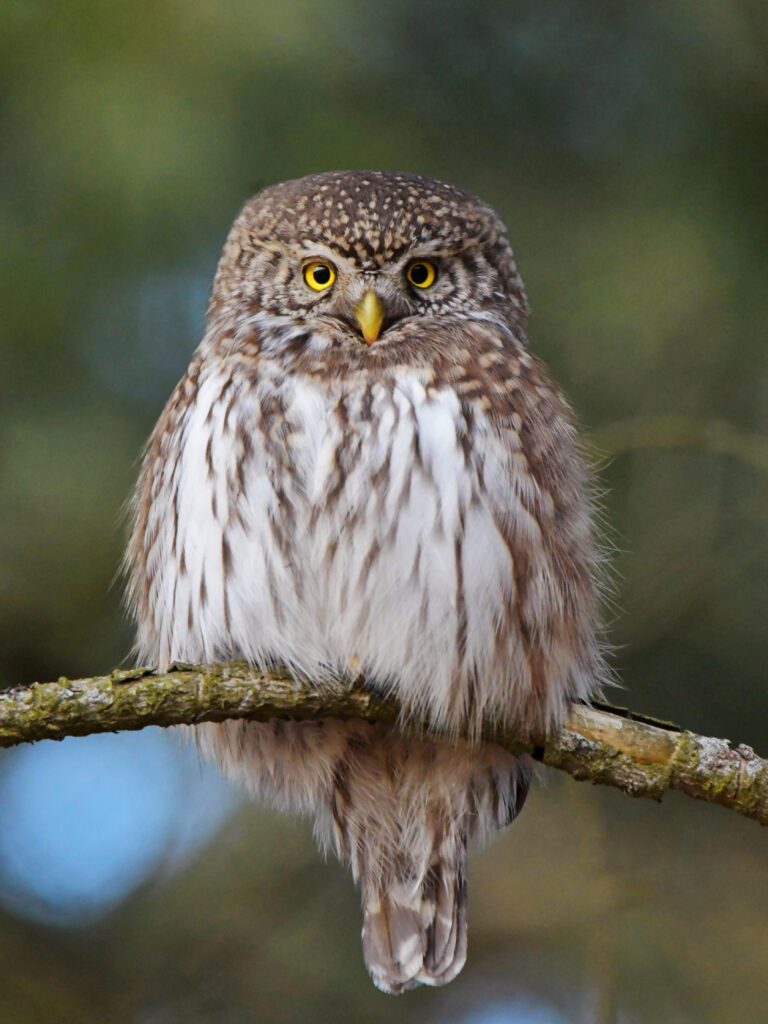
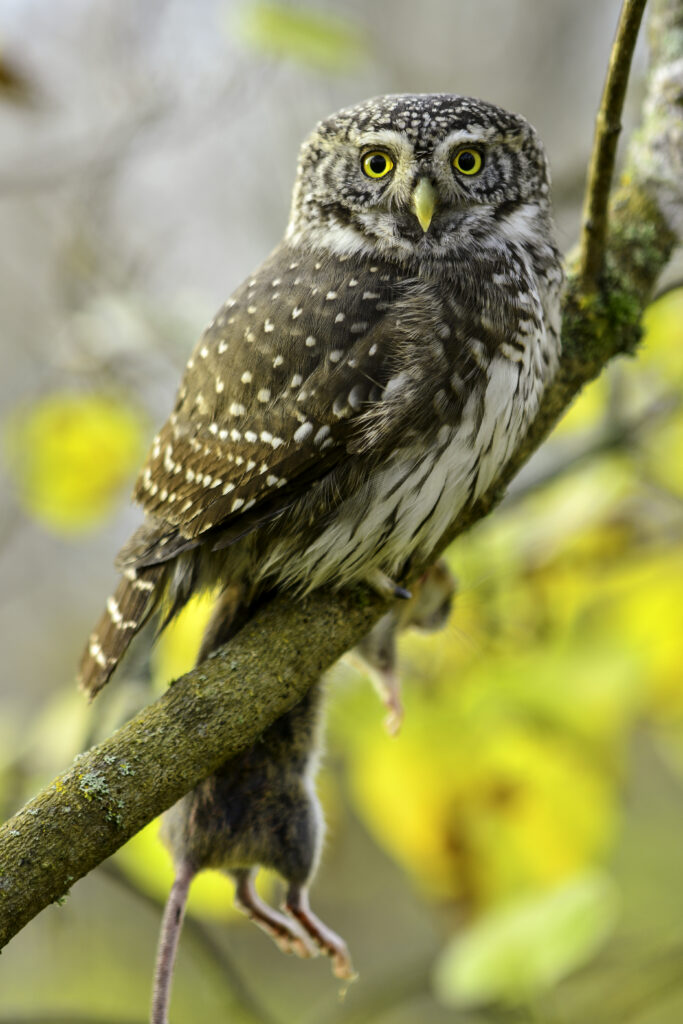
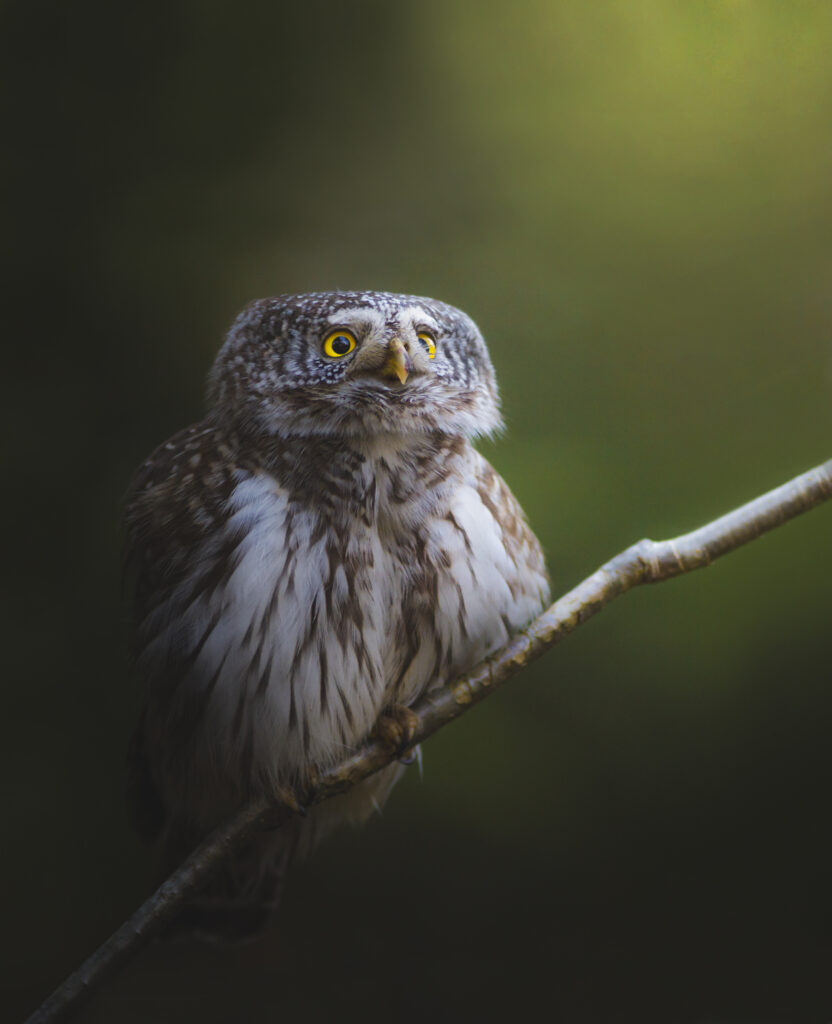
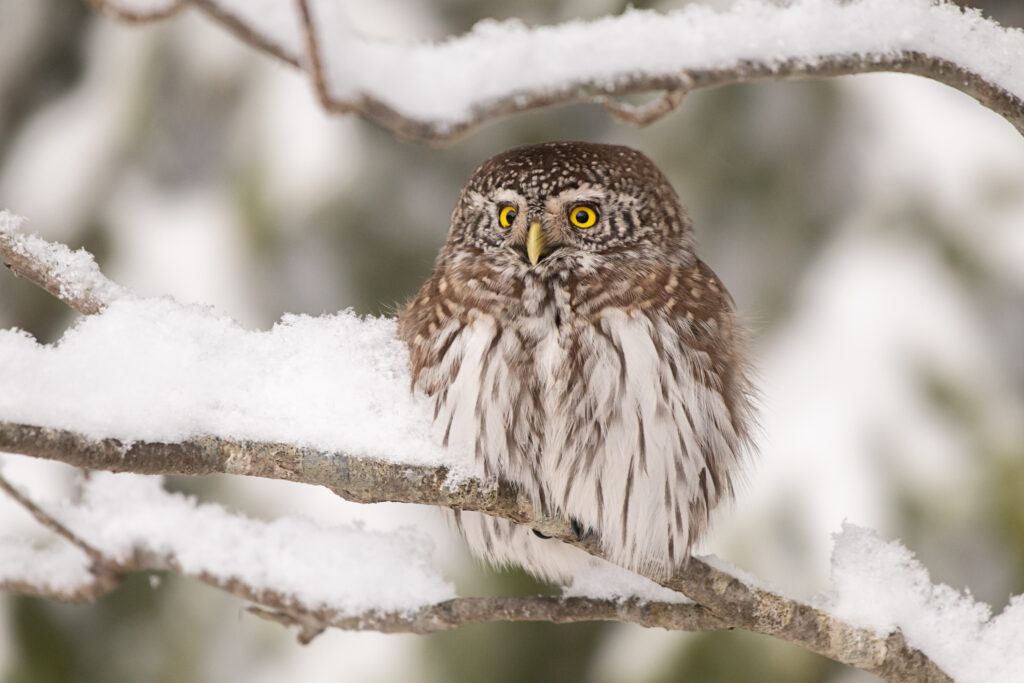
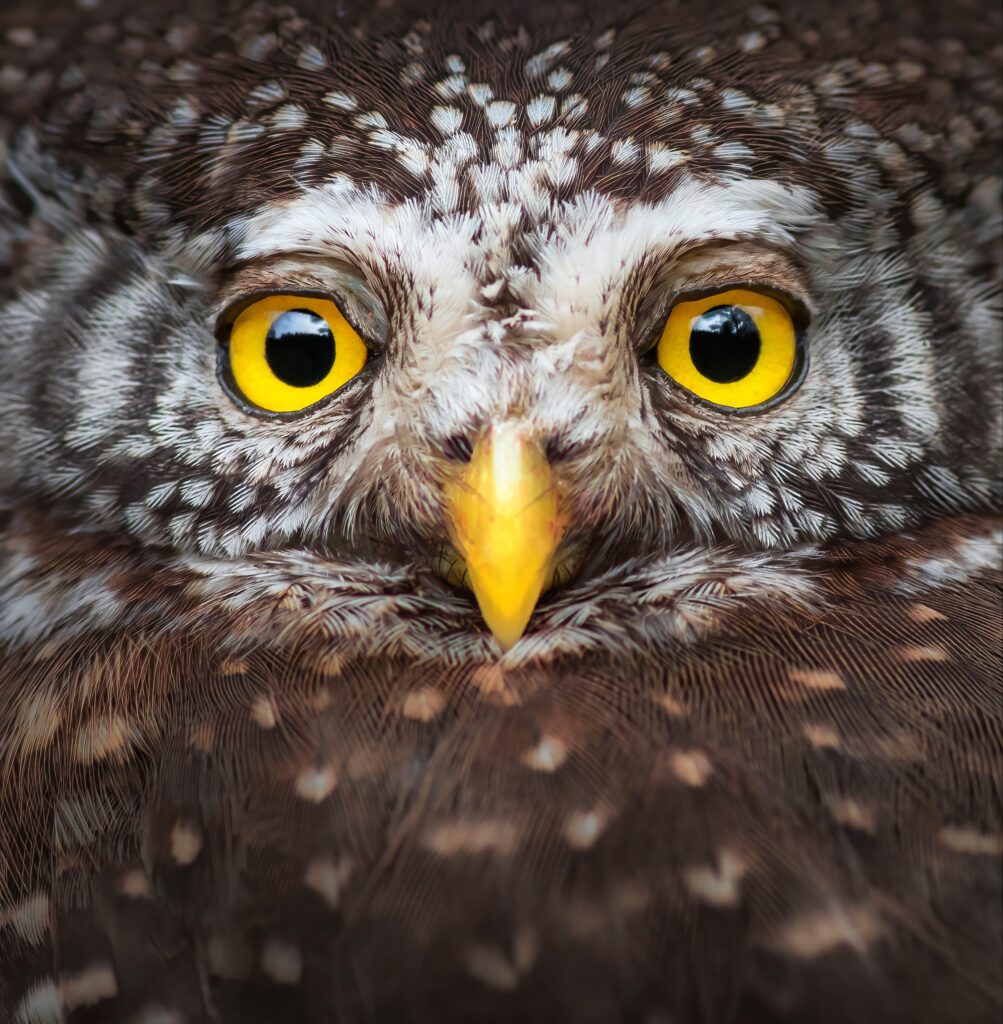
A gallery of photos submitted to the "Green Treasures" photo contest features beautiful images of this tiny owl.
The pygmy owl is truly small—about the size of a starling—with a relatively small, round head. Its back is dark brown with fine pale spots, and its belly is whitish with brown vertical streaks. The facial disc is subtle and mottled. The eyes are yellow, and unlike some other owls, the pygmy owl does not have ear tufts. It has a hooked, greyish-yellow beak and proportionally large feet, which allow it to lift and hold surprisingly large prey. The legs and toes are yellowish with black claws.
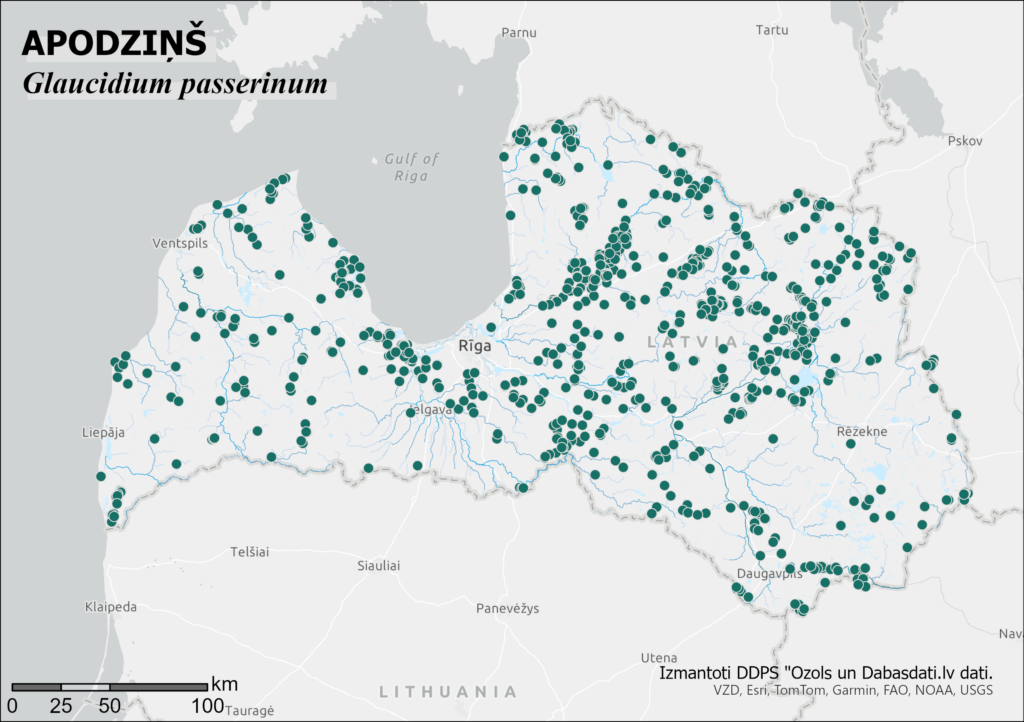
This species can be identified by its distinctive calls, which vary seasonally. Both males and females can produce similar whistling sounds. Until the early 21st century, the pygmy owl was considered rare in Latvia, largely because owl surveys were typically conducted at night. However, it was discovered that pygmy owls are most active during twilight hours, when their main prey—voles—are also active. This insight led to a shift in survey methods and helped gather more accurate data on the owl’s presence in Latvia.
The greatest threat to the pygmy owl in Latvia is forestry activity, which destroys its habitat and causes disturbance. Logging during the breeding season can cause nest abandonment. A decline in rodent populations can also negatively affect breeding success. Disturbance from photography or other human activity can also pose a threat. Furthermore, climate change is expected to have a negative impact on Latvia’s pygmy owl population.
In the LIFE FOR SPECIES project, the pygmy owl is classified as a vulnerable species (VU).
This February, we shine the spotlight on the freshwater pearl mussel (Margaritifera margaritifera)—a species assessed in our project as Endangered (EN), facing a very high risk of extinction in the wild.
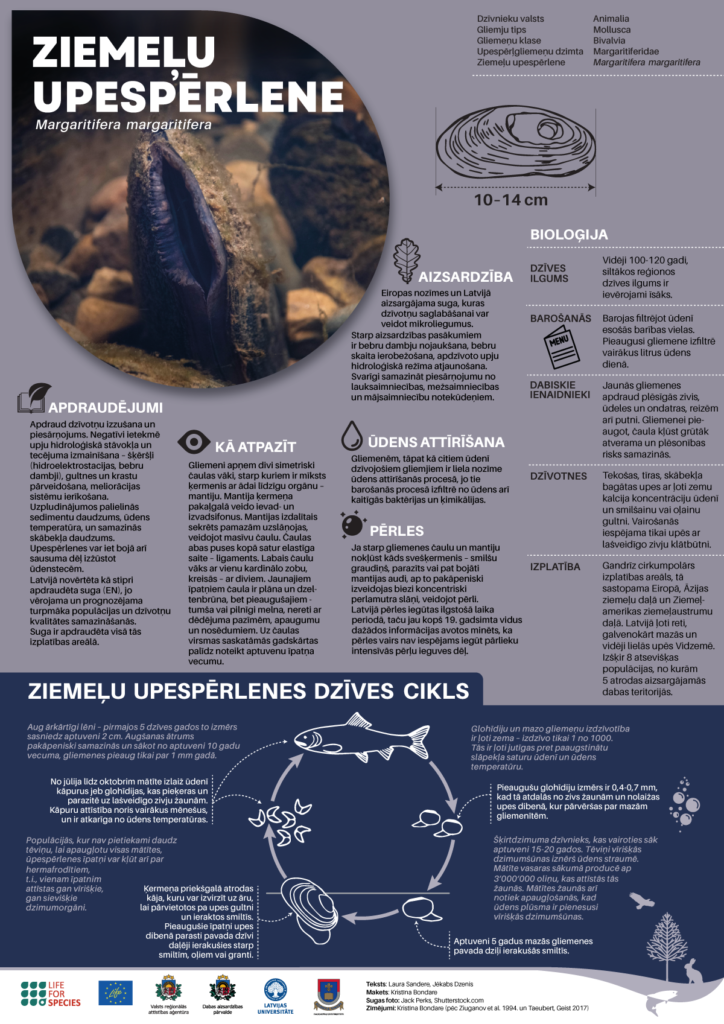
How can you recognize the species?
The mussel is enclosed by two symmetrical shell valves, which protect its soft body and a skin-like organ called the mantle. At the rear end of the body, the mantle forms the inhalant and exhalant siphons. The mantle secretes material that gradually builds up the thick shell.
The two shell halves are held together by a flexible ligament. The right valve has one cardinal tooth, while the left has two. Juvenile mussels have thin, yellow-brown shells, whereas adults have dark or completely black shells, often showing signs of wear, encrustation, or sediment deposits. The visible growth rings on the shell surface can help estimate the mussel's age.

If a foreign object—such as a grain of sand, a parasite, or damaged mantle tissue—gets trapped between the shell and the mantle, the mussel gradually covers it with thick concentric layers of nacre (mother-of-pearl), forming a pearl. In Latvia, pearls were historically harvested over a long period. However, since the mid-19th century, various sources have noted that pearls could no longer be collected due to overharvesting.
In Latvia, the species is threatened by habitat loss and water pollution. The main risk is juvenile mortality in the first few years of life, as the young are extremely sensitive to elevated nitrogen levels in the water. The species also suffers from changes in river hydrology and flow, including obstacles like hydropower plants, beaver dams, as well as riverbed and bank alterations and drainage system installations. In dammed areas, sediment levels and water temperatures rise, while oxygen levels drop. Pearl mussels can also perish during droughts when streams dry out.
On January 22, 2025, the Estonian Environmental Board hosted a conference in Tartu titled “Eesti kaitsealuste liikide nimekirjade kaasajastamine” (“Updating Estonia’s List of Protected Species”).

The aim of the conference was to introduce professionals working in Estonia’s environmental sector to the plans and actions for updating the national list of protected species, present the current situation regarding species conservation in Estonia, and more.
At the event, Dmitry Telnov, the coordinator of the invertebrate species group within the LIFE FOR SPECIES project, representing the University of Latvia’s Institute of Biology, was invited to deliver a presentation titled “Towards a New National List of Protected Species in Latvia: LIFE FOR SPECIES Project Approach.”
The Latvian LIFE FOR SPECIES project was praised during the conference for its systematic approach to preparing Latvia’s list of protected species, transparency, and criteria-based methodology. The project was also commended for its significant contributions to communication efforts related to species conservation and project activities, including seminars, exhibitions, conferences, and interviews. Participants expressed interest in Latvia’s planned and existing categories of species protection, as well as in the financial benefits associated with species conservation.
Other presenters at the conference represented the Estonian Environmental Board, the Estonian Ministry of Climate, and the University of Tartu. In total, there were eight presentations.
A significant portion of the conference was dedicated to questions from experts and other attendees directed at the Estonian Environmental Board, which is coordinating the project to update the national list of protected species (2024–2028). The project is currently in its initial phase and aims to review the status and categories of all species already included in the list. However, the list itself will remain unchanged. This means that all species currently listed as protected in Estonia will retain their status after 2028, though some may be reclassified into different categories based on their current population status. Additionally, the system of species protection categories in Estonia will not undergo changes.
The conference was attended by over 220 participants, including more than 120 in person and over 100 joining online. The attendees represented various Estonian environmental institutions, NGOs, and other organizations, including nearly all of Estonia’s environmental experts.
For more information about the conference, visit: https://www.keskkonnaamet.ee/sveitsi-eesti-koostooprogrammi-elurikkuse-programm
Do you know which fish can move short distances on land and even climb to overcome obstacles? This month's protected species is the European eel (Anguilla anguilla). These remarkable abilities help the eel navigate small barriers and forage along the edges of water bodies.
The European eel is classified as Critically Endangered (CR) both in Latvia and globally. It faces numerous threats, including overfishing, disease, illegal trade, pollution in rivers and seas, migration barriers, and changes in the Gulf Stream.
Unfortunately, the European eel is also the most frequently trafficked wild species in Europe. Every year, around 100 tonnes of glass eels are illegally caught along the European coast and smuggled to Asian countries. The high demand for eel meat as a delicacy drives this black market, with the price of glass eels reaching several thousand euros per kilogram.
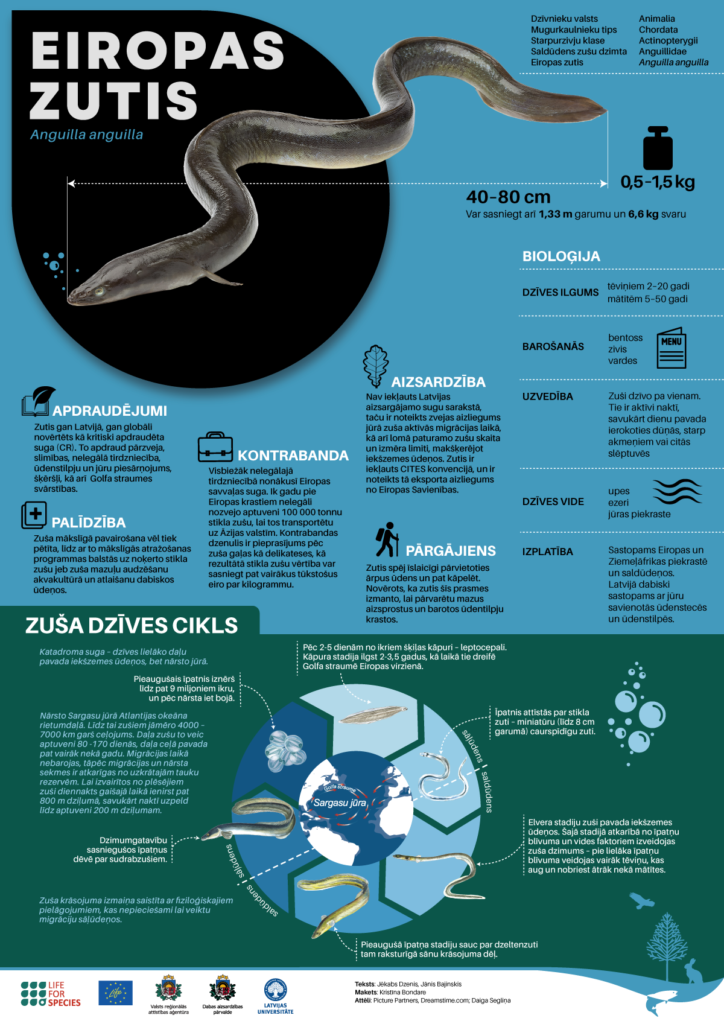
Learn more about the European eel in the eel fact sheet. The PDF version is available here.
Fact sheet design by: Kristīna Bondare.
The LIFE FOR SPECIES project began on December 1, 2020, and was initially scheduled to conclude at the end of 2024. However, the project assessed one-third more species than originally planned, significantly increasing the workload. To complete all planned activities, the project has been extended until the end of 2025, and the new Red Data Book is also expected to be released this year.
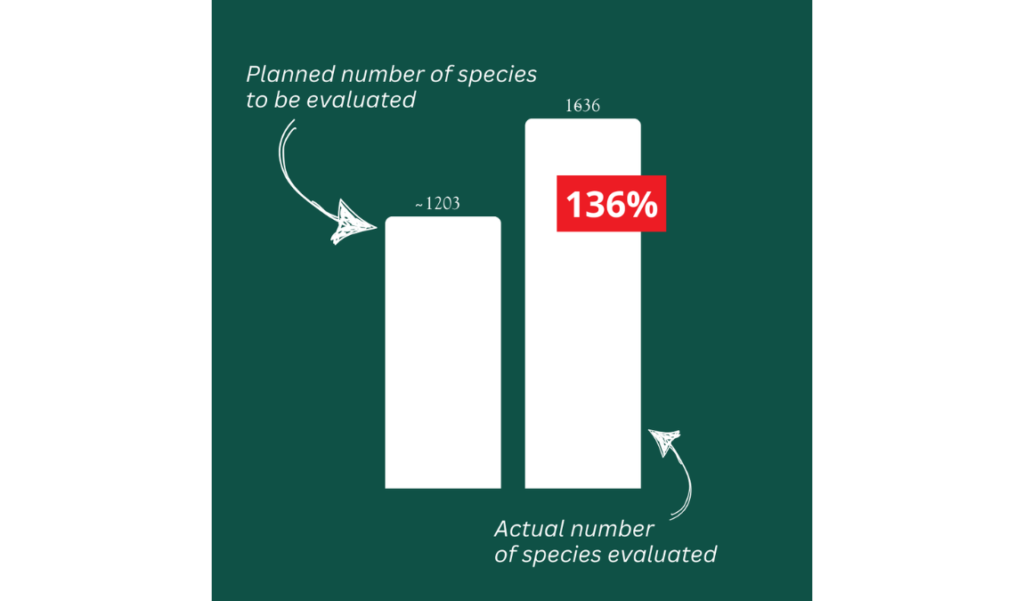
While the Red Data Book is being finalized, we invite you to explore publications prepared by experts on the evaluation results of various species groups:
In 2025, we will continue to host educational events and share updates about the project through various communication channels, including our social media accounts and the project website. Later this year, we will announce details about the book launch event and the project’s closing event. Follow us on social media (Instagram, Facebook) to stay up-to-date with the latest news!
The aims of the LIFE FOR SPECIES project are to update the list of protected and endangered species based on scientific criteria, to prepare proposals for changes in legislation, to improve data quality and availability of species, as well as to increase public and stakeholder awareness, and active species protection in Latvia.
As December draws to a close, let's talk about one of the smallest predator species in Latvia – the stoat (Mustela erminea).
Currently, the stoat's fur is white, but in summer, it changes to brown with a whitish throat and belly. The tail is three times shorter than the body and has two colors – brown during summer and white in winter. The tail tip is always black. The easiest way to distinguish a stoat from a weasel is by its tail: the stoat's is longer, slender, and bi-colored, while the weasel’s tail is noticeably shorter, stubbier, and single-colored.
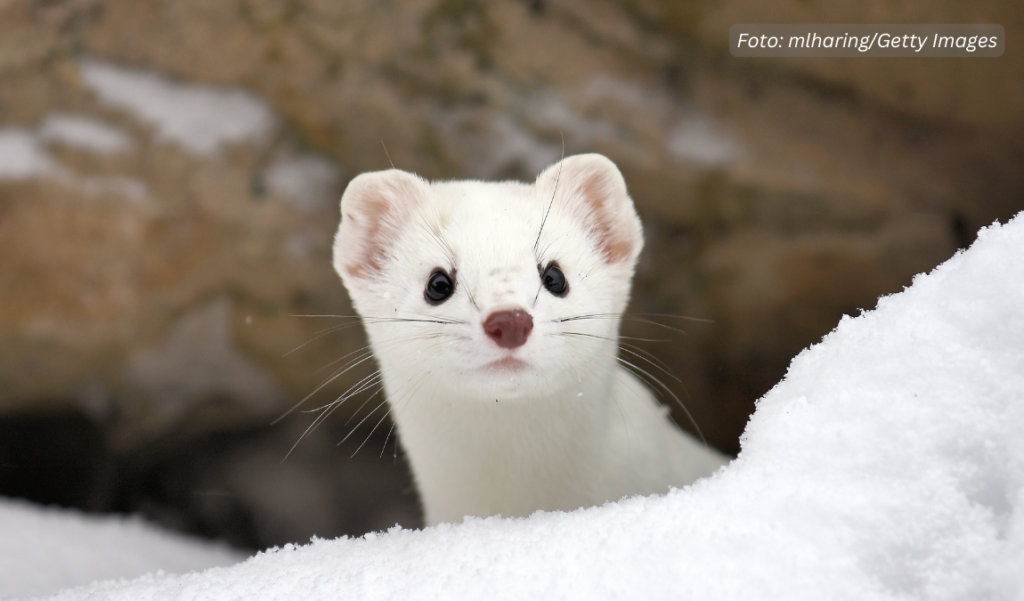
The stoat is a predator with a slender, flexible body. It measures 20–27 cm in length and weighs up to 200 g. Stoats are crepuscular and nocturnal but can be active at any time of day. They remain active year-round.
The stoat lives in forest edges, shrublands, and, most commonly, along water bodies and small low-lying marshes. In winter, it may settle near human habitation, including rural homes. It hides in piles of stones, branches, or logs, fallen tree hollows, and burrows. Females create a permanent den only during the breeding season (March–May).
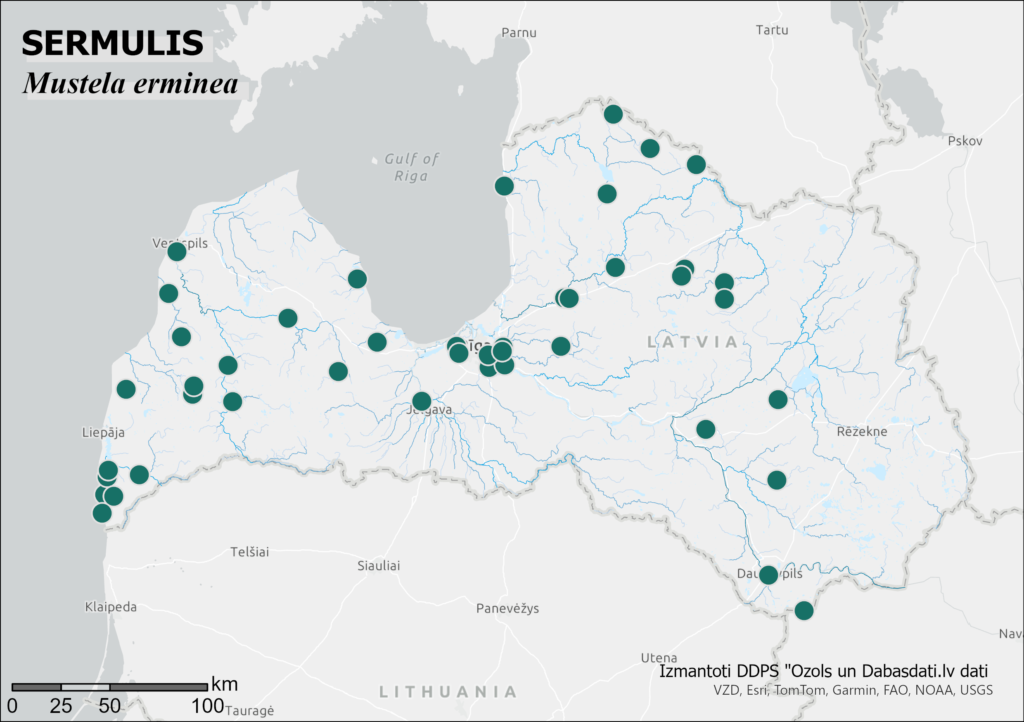
Their primary prey consists of vole-like rodents, which they primarily hunt in burrows. They also eat shrews, frogs, lizards, insects, birds and their eggs, and wild berries. Stoats are efficient hunters and, if food is abundant, will kill more prey than they can eat, storing the excess as reserves.
Stoats are polygamous and reproduce once a year. Litters can range from 3 to 18 kits, averaging 4–9. The female alone cares for the young.
The kits grow rapidly and can hunt with their mother by the eighth week. While females reach adult size at least six weeks after birth, they can mate as early as 60–70 days old, often before they are weaned. Males, however, do not reproduce or reach full size until their second summer.
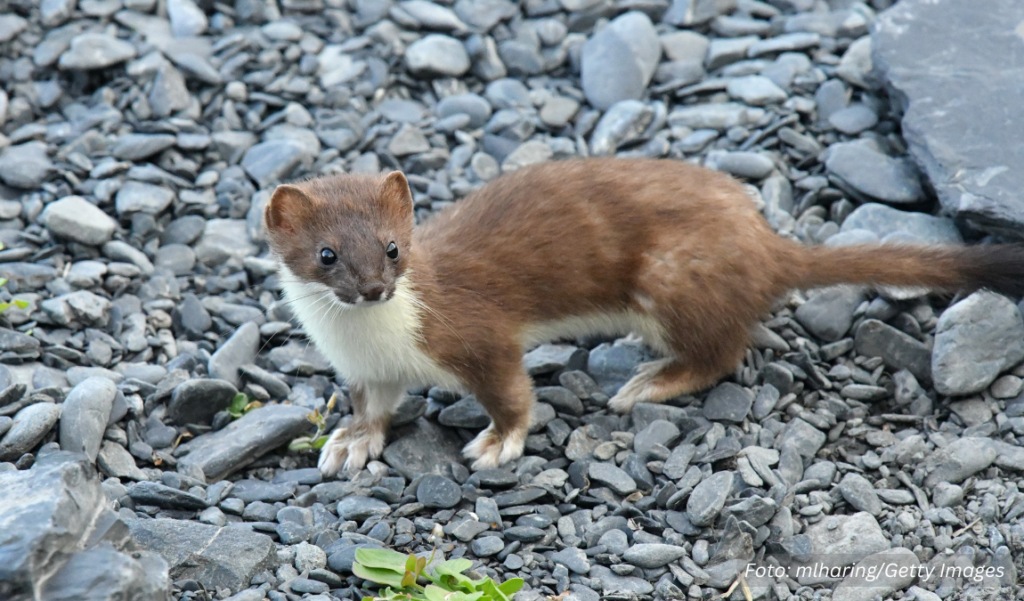
Females in the wild typically survive at least two breeding seasons, while males often do not live as long. Reproductive success largely depends on food availability.
Stoats rest and den among tree roots, hollow logs, or abandoned burrows taken over from rodents (stoats do not dig their own burrows). An individual’s territory includes multiple dens lined with dry vegetation or fur and feathers from prey. In times of plenty, stoats store food in side chambers of burrows.
In Latvia, the threats to stoats have not been well studied. However, similar to other regions, stoats may be affected by agricultural and forestry intensification, leading to habitat loss and reduced prey availability. Populations are also limited by the invasive American mink, which preys on stoats and competes for food.
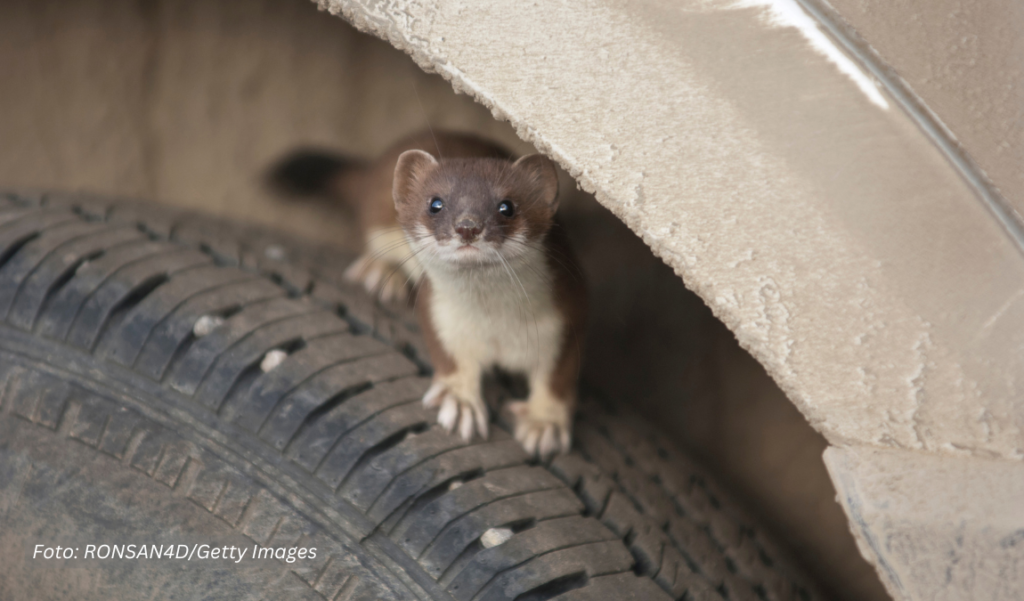
The stoat is classified in Latvia as a species with insufficient data (DD, Data Deficient) to fully assess its conservation status.
As November comes to an end, we want to highlight a very rare species – the Stiff Apple-moss (Bartramia ithyphylla). This moss has been assessed as critically endangered (CR) in our project, but we have some great news – a new population of the species was discovered in Latvia this summer!
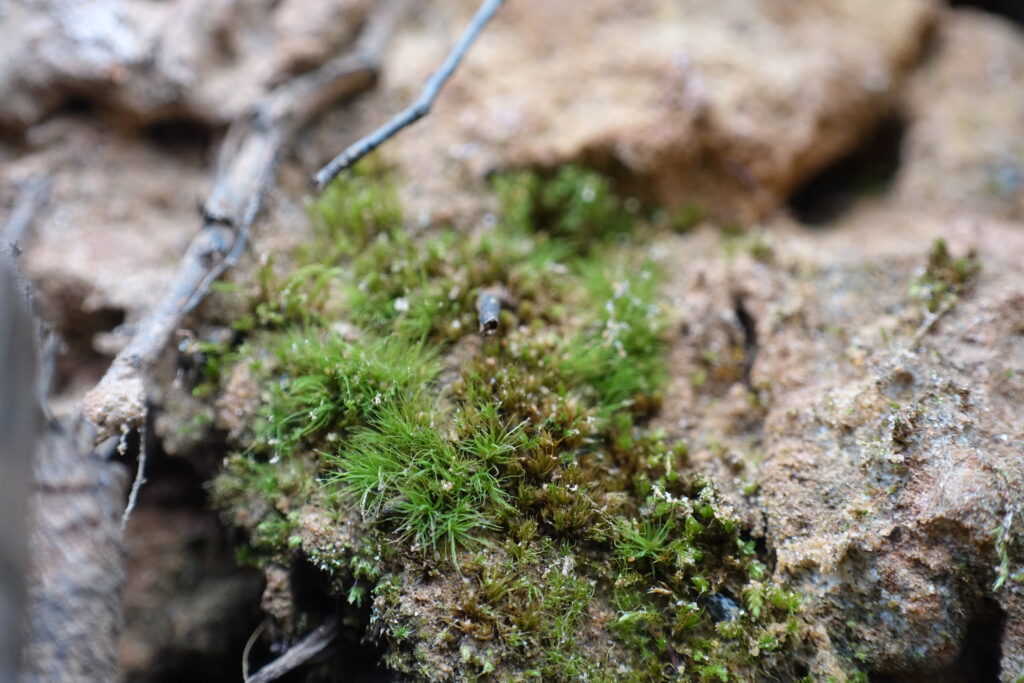
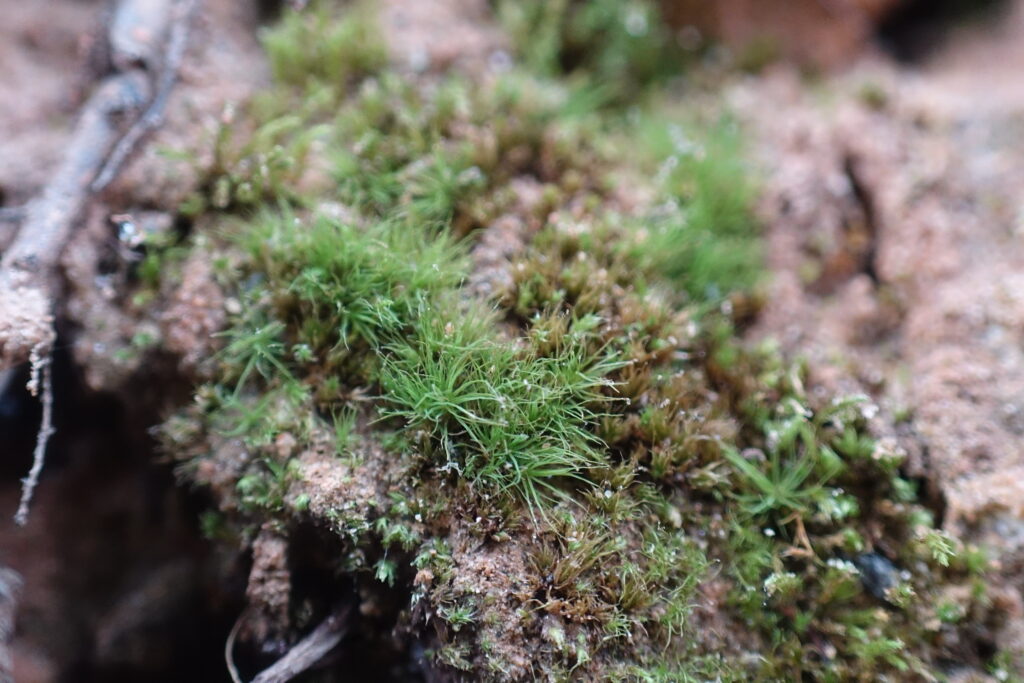
The Stiff Apple-moss is a leafy moss with colors ranging from soft green to bluish hues. When its leaves are dry, they are stiff and upright, but in moist conditions, they bend and become linear. The leaf edges are thin and toothed, with two rows of small teeth, while the leaf tip is pointed.
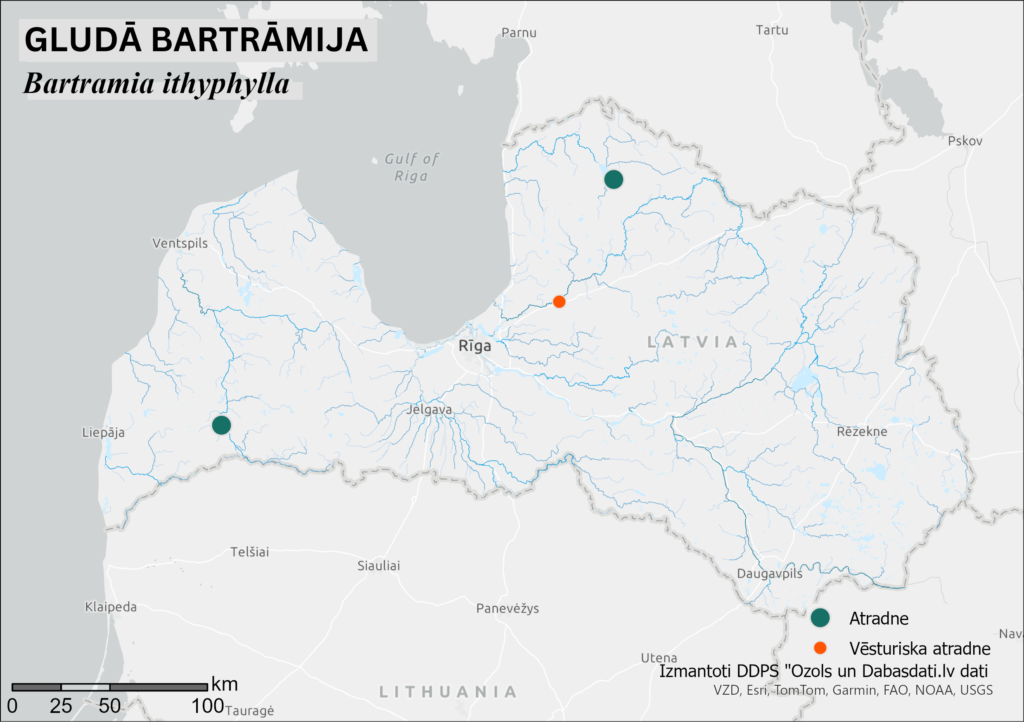
In Latvia, the species has two historical sites: one near Cēsis, along the Gauja River, and another in the Alsunga area of Kurzeme. Additionally, there are two modern sites: one in Central Kurzeme, in the Venta and Šķervelis valley near Lēnas, where it grows in an area of approximately 3x5 cm. The most recent site was discovered in 2024 by LIFE FOR SPECIES bryophyte expert Līga Strazdiņa on a sandstone outcrop along the shore of Lake Burtnieki. The species is not tied to any specific region of Latvia but depends on the availability of suitable habitats and substrates.
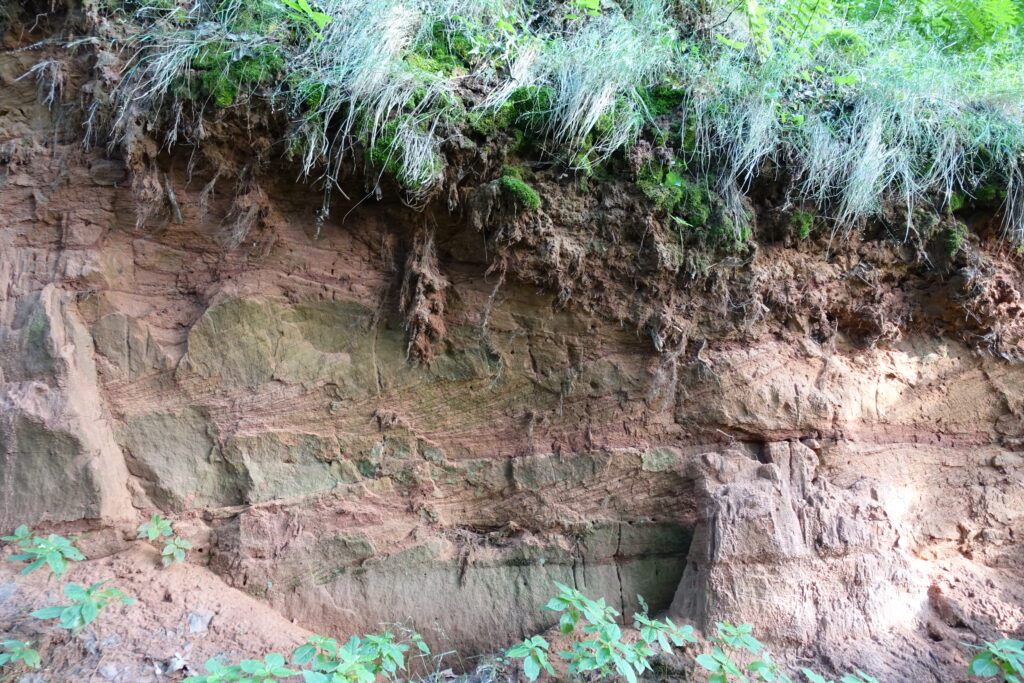
Elsewhere in Europe, Stiff Apple-moss is a widespread mountain species, found in various habitats growing on rocks and in rock crevices. In Latvia, it has been recorded on sandstone cliffs, dolomite outcrops, and clayey slopes along roadsides.
The species faces threats from increased tourism activity, damage to cliffs, and "improvements" to cliff areas, such as the removal of shrubs and trees to enhance scenic views. Such activities can lead to excessive exposure to sunlight, worsening the moss's growth conditions.
During the autumn months, we want to share more information about two bird species that have recently appeared in many social media posts by residents of Latvia – the western capercaillie (Tetrao urogallus) and the black grouse (Lyrurus tetrix). While these birds might seem similar at first glance, they differ in both appearance and behavior.
In this article, we will explain how to distinguish between these two species and provide more details about their characteristics and conservation.

One of the main differences between the two species is their size, especially among the males. The black grouse is roughly the size of a chicken, while the western capercaillie is closer in size to a turkey. Distinguishing between the females of these species can be more difficult, as the size difference is smaller, and both females have a brown mottled coloration. However, one "cheat code" is the rusty-orange coloration on the breast of the capercaillie female.
Western capercaillies feed on pine needles during winter, whereas black grouse are often seen eating birch buds in winter, where they are easily visible on bare birch trees from a distance. Both species may spend nights in the winter sleeping under snow (if it's deep enough), as it provides insulation and warmth.

The male is bluish-black with a greenish sheen on the chest. Its wings are black-brown with a white shoulder patch, and the tail, belly, and sides have white spots. The female is smaller, with a reddish-brown mottled appearance and a brown crescent-shaped patch on the chest.
For most of the year, the western capercaillie feeds on pine needles, while in spring, the flowers of cotton grasses become important, and in summer, it feeds on various buds and flowers, especially blueberry.
In spring, the species is known for its elaborate courtship ritual, where males gather at specific sites (called leks) to sing and mate with females. The males are polygamous
The nest is built on the ground near tree roots or in similar locations, with a clutch of 5–11 eggs. There is one brood per year, and the young are precocial. The female raises the young on her own. The western capercaillie is a resident species.
Most of the western capercaillie lekking areas are dominated by pine forests. These leks are typically located in more natural forests with plenty of fallen trees, dry areas, and old trees. The capercaillie mainly leks in forests over 60 years old.

The species is threatened by various forms of forestry activities: habitat fragmentation, replacement of old forests with new stands, replacement of pine with spruce, and more. The species is also threatened by road infrastructure.
The project has assessed the species as endangered (EN), meaning it faces a very high risk of extinction in the wild.

The black grouse is a chicken-sized bird. The male has black plumage with a violet sheen and a white under-tail. Its tail is lyre-shaped, and it has red eyebrows. The female is smaller and reddish-brown. Both sexes have a white stripe on the wing in flight, but the female's stripe is narrower.
The black grouse is a social bird, especially the males, which stay in groups year-round.
Adult birds feed on plant-based food, including undergrowth plants (such as lingonberries, blueberries, and heather) as well as buds, shoots, and flowers of trees like birch and alder.
The young chicks feed mainly on insects during the first weeks of life and gradually transition to plant-based food.
In spring, males gather at leks, where they sing, fight, and mate with females. The males are polygamous. The nest is built, eggs are incubated, and the young are raised by the female alone.
The nest is on the ground, typically near a tree trunk or under the cover of shrub branches, with 6–12 eggs per clutch. There is one brood per year, and the chicks are precocial. The black grouse is a resident species.
The black grouse inhabits forest edges, primarily in transitional habitats between forests and open landscapes – forest edges, young regenerating stands after fires, windthrow areas, and clear-cuts, as well as agricultural land adjacent to forests, shrublands, and moss and grass bogs. The presence of trees is important for the black grouse, but they should not be in dense stands.

In Latvia, the black grouse can be hunted from September 1 to December 31, though hunting is minimal.
The species is threatened by forestry activities that fragment habitats, increase predation risk, and cause disturbance. Habitat degradation also occurs due to the drainage of bogs. Significant threats also include predation and disturbance from recreational activities.
The project has assessed the species as vulnerable (VU).
Last week saw the successful conclusion of the LIFE FOR SPECIES international conference "Safeguarding Biodiversity: Red Lists and Beyond." The conference took place from September 18-20 in Riga, with participants also having the option to join remotely (hybrid format). The event attracted over 140 participants representing 14 countries, including the Philippines, Nepal, and the USA.
On the first day of the conference, participants had the opportunity to join one of four excursion groups organized in collaboration with the participants of the "Nordic Baltic LIFE Platform meeting".

The variety of routes provided participants with a chance to explore protected species in Sigulda, river restoration mechanisms in northern Latvia, conservation efforts in the Krustkalni Nature Reserve, and nature conservation examples in the western Latvian region. Each route offered an in-depth look at the achievements of Latvian LIFE projects, sharing valuable experience in species and nature conservation.

On the second day of the conference, September 19, there was a formal opening ceremony, followed by 11 diverse and educational oral presentations on species conservation cooperation, species monitoring, and other related topics. Participants also had the opportunity to view and discuss 27 poster presentations.
For more information about the conference, please visit the conference website. A detailed program can be found here.
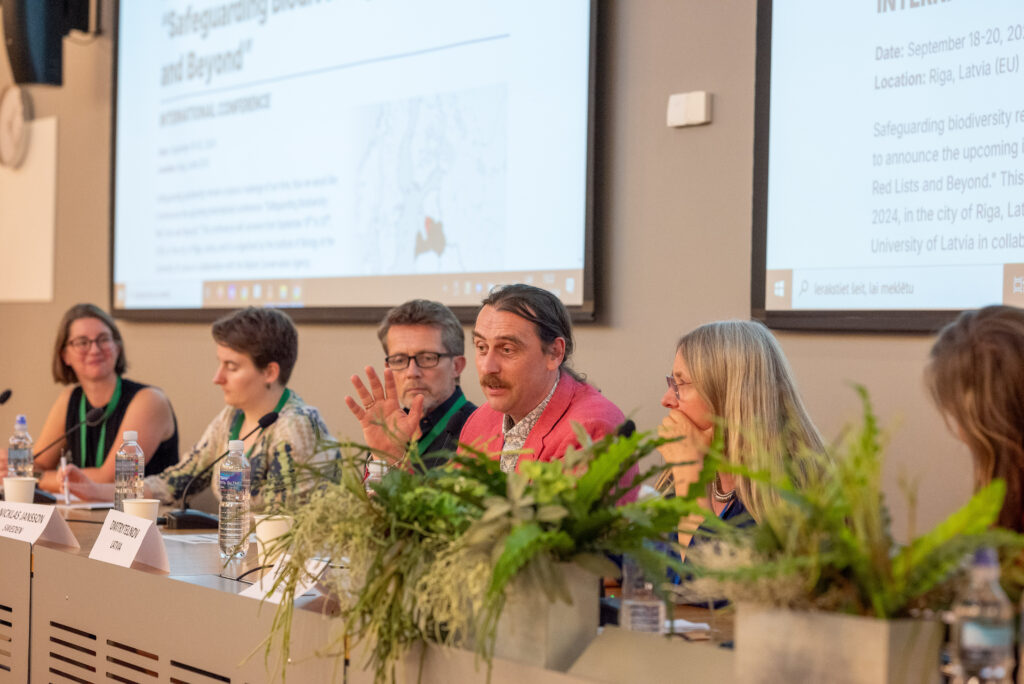
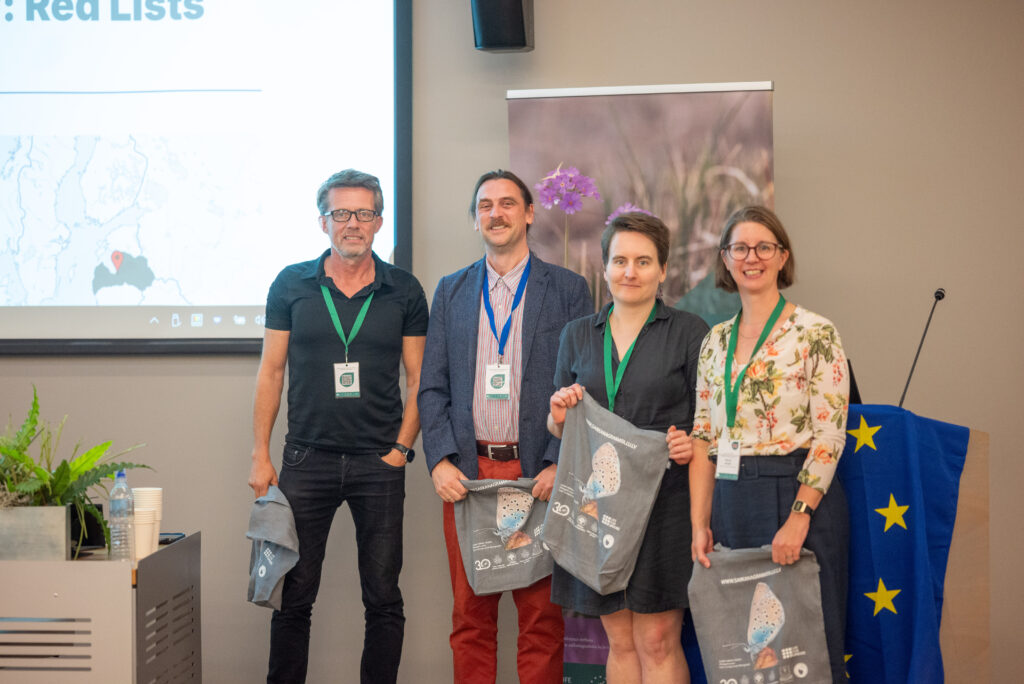




On the final day of the conference, September 20, 13 presentations were delivered on topics such as nature communication, various species protection mechanisms, and many others. Additionally, a database session titled "Biodiversity Data Systems: Storage, Analysis, and Sharing" was held, featuring 9 reports led by Jēkabs Dzenis, coordinator of the Nature Conservation Agency's project.

During the two presentation days, participants had the opportunity to vote for their favorites from oral presenters, poster presentations, and the database session. At the conclusion of the event, the project manager awarded diplomas and small mementos to the winners.
Among the oral presenters, the audience's favorite and first-place winner was keynote speaker Nicklas Jansson from Sweden, who gave an in-depth presentation on innovative solutions for creating habitats for protected invertebrate species. The second place went to Narayan Prasad Koju from Nepal, who joined remotely and shared insights into snow leopard research, community involvement in studies, and the harmony between people and nature in the mountains of Nepal.
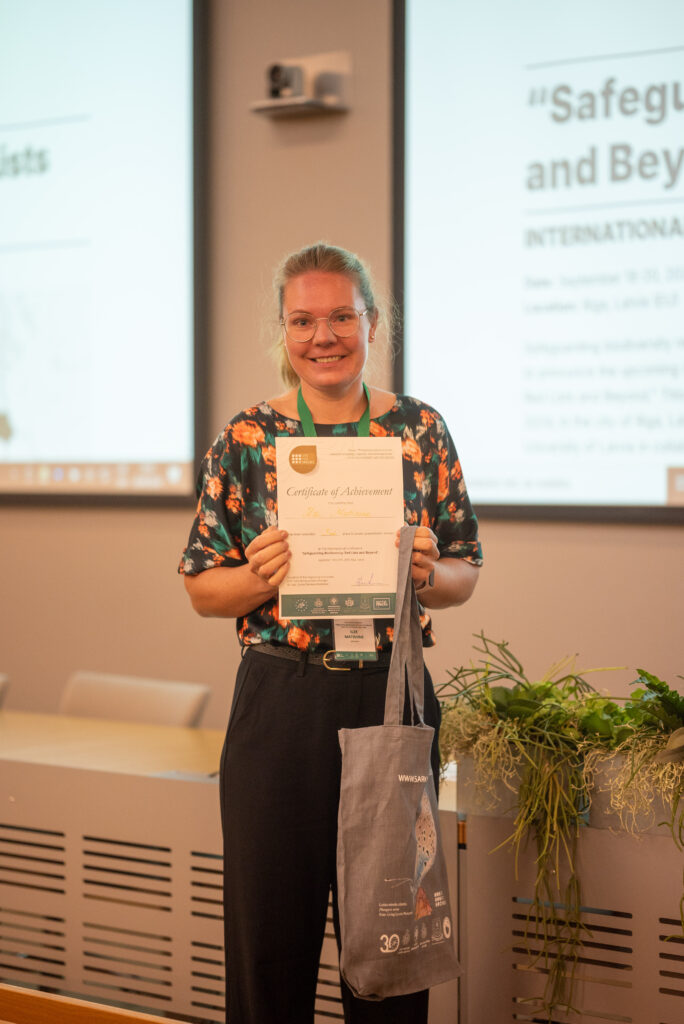
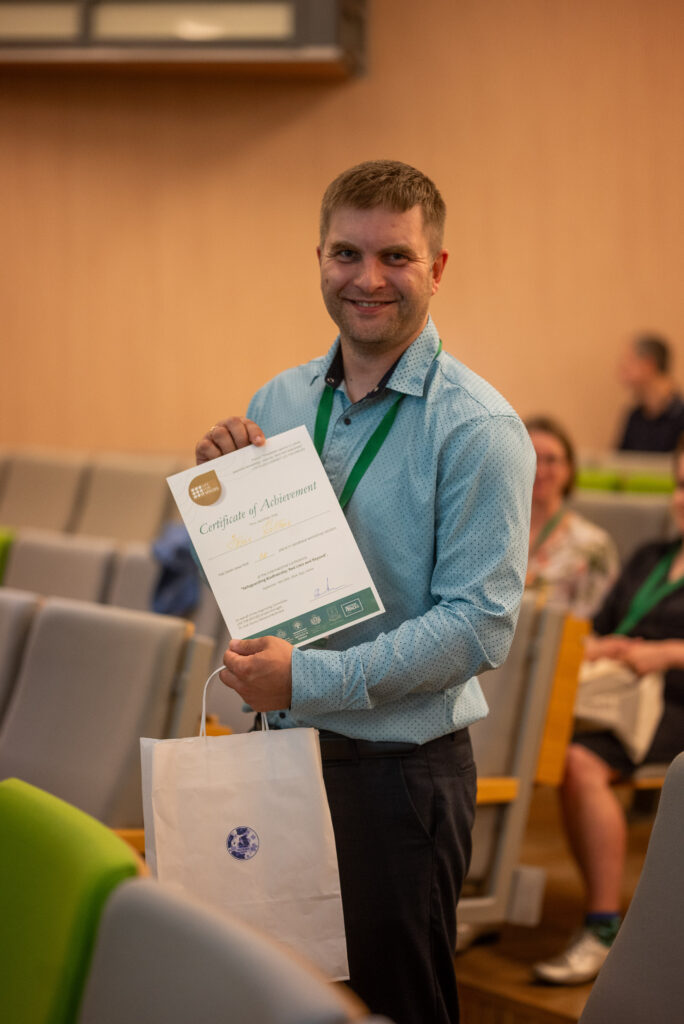
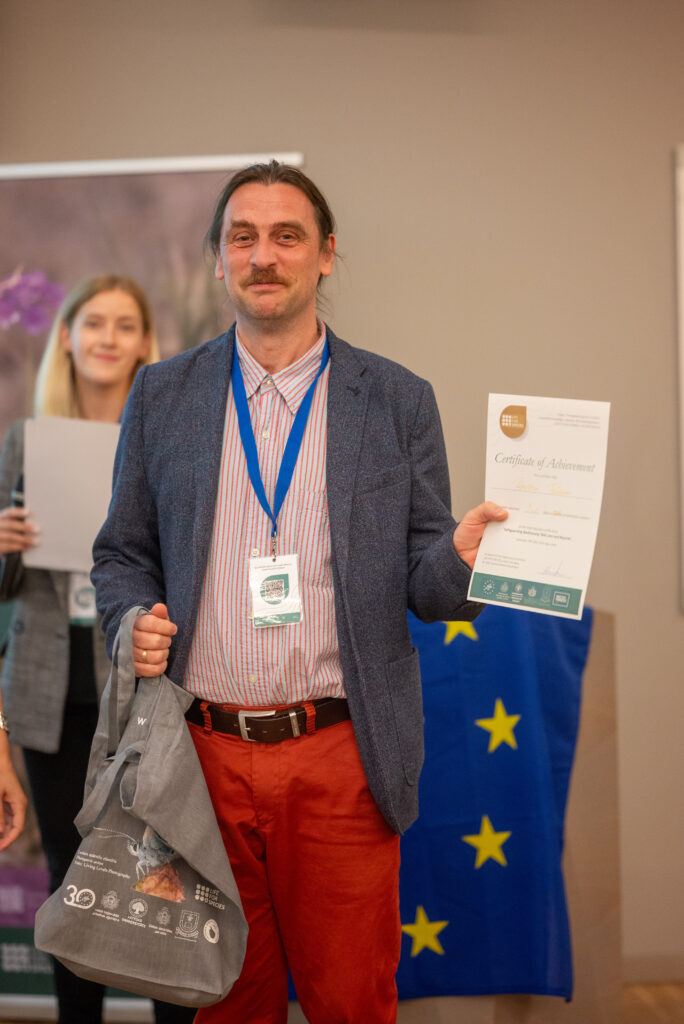
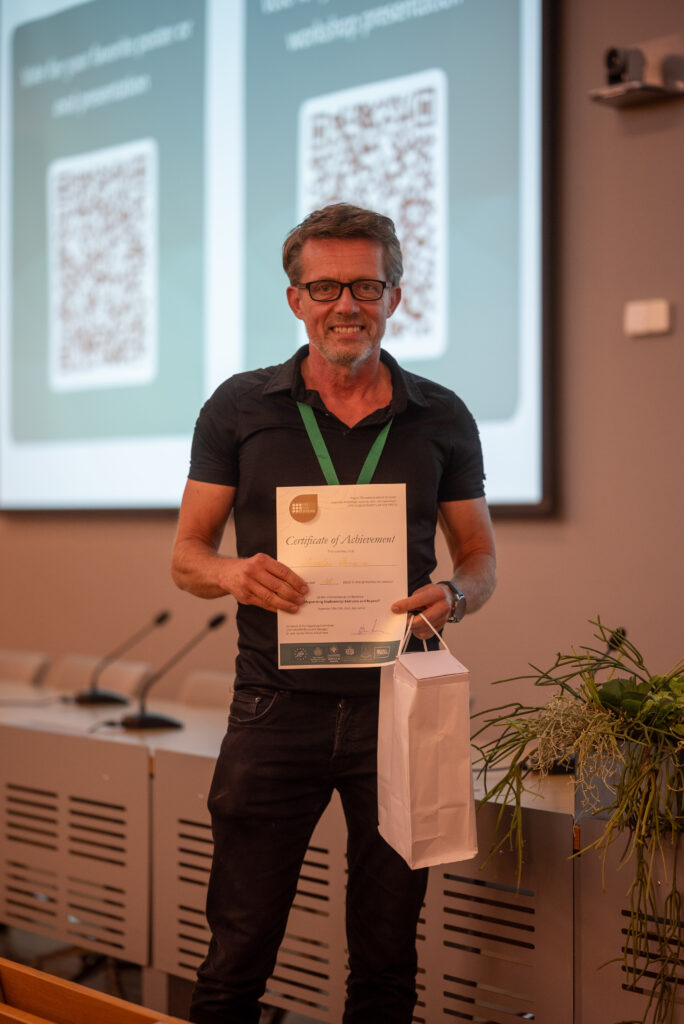
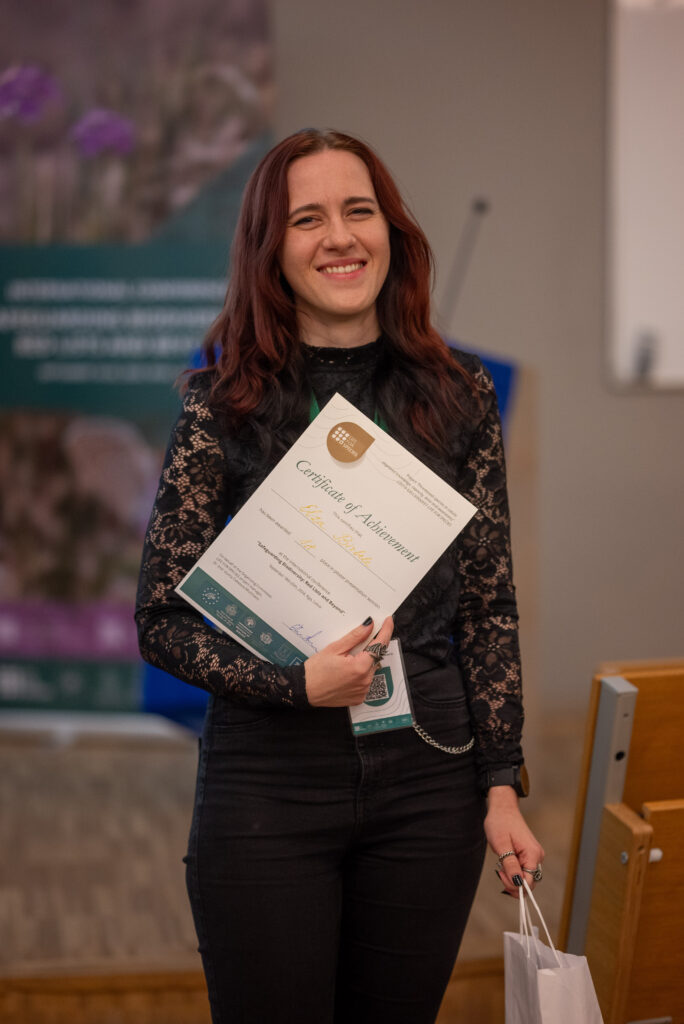
Third place was awarded to Dmitrijs Teļnovs, leader of the invertebrate species group of the LIFE FOR SPECIES project from the University of Latvia and keynote speaker, whose presentation highlighted the project's achievements in protecting rare and endangered species in Latvia.
In the poster session, Elza Birbele won first place for her poster on the identification of natterjack toads after their release into the wild. Second place went to Rūta Starka for her poster on the IUCN assessments of grasshopper species in Latvia. Ilze Matisone took third place with her presentation on the condition of young ash stands in Latvia after their dieback.
In the database session, participants voted for the best presentation, with Jānis Kotāns winning for his presentation on the national database "OZOLS."
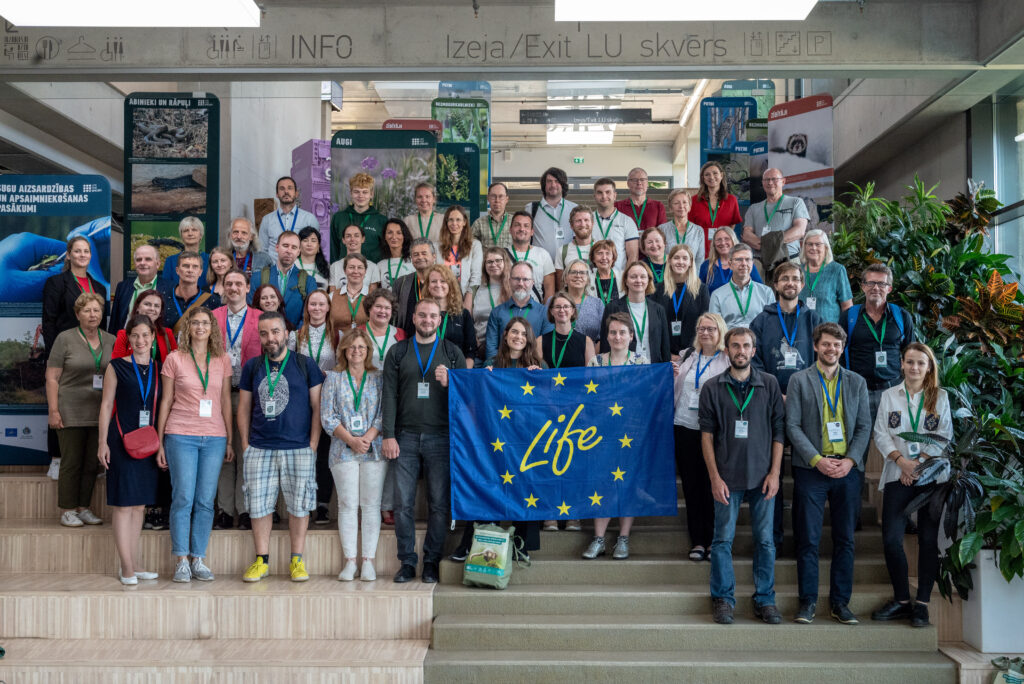

In total, the conference featured 33 oral presentations, including 6 keynote speaker presentations and 27 poster presentations. The diversity of presentation topics can be explored in the conference's Book of Abstracts.
LIFE FOR SPECIES project participants delivered 17 presentations at the conference:
A huge thank you to all the participants and the organizing team for their hard work in making the conference a success!

Special thanks to the volunteers: University of Latvia students Jeļena Mjagkova and Barbara Auzāne.
The conference was organized by the LIFE FOR SPECIES project – the University of Latvia's Institute of Biology in collaboration with the Nature Conservation Agency, Daugavpils University, and the French Institute in Latvia.